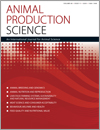
Animal Production Science
Volume 60 Number 11 2020
Water scarcity is one of the main challenges threatening the sustainability of livestock production systems. The present review describes approaches used to quantify water use in livestock production, and the water footprint of the main animal products. The review also highlights possible strategies to reduce water use in livestock sector and reduce the global water shortage.
AN18606Sirt1 regulates the expression of critical metabolic genes in chicken hepatocytes
Sirtuin 1 (SIRT1) has many functions including regulating liver metabolism in mammals, but the function of SIRT1 in the chicken is completely unknown. We found that Sirt1 is expressed in the liver and many other organs in the chicken. Sirt1 regulates the expression of many genes involved in metabolism in the chicken hepatocytes. These findings highlighted Sirt1 critical roles in carbohydrate and lipid metabolism in chicken liver.
AN18612Association of CAST-gene polymorphism with mRNA levels and meat tenderness in goats
 , Angélica de Souza Khatlab
, Angélica de Souza Khatlab  , Pedro Veiga Rodrigues Paulino, Juliana Chaves da Silva, Pedro Cesar Nehme de Azevedo and Maria Amélia Menck Soares
, Pedro Veiga Rodrigues Paulino, Juliana Chaves da Silva, Pedro Cesar Nehme de Azevedo and Maria Amélia Menck Soares 
The most relevant factor when consuming meat is tenderness In an attempt to predict the tenderness without having to slaughter the animal, scientists have been looking for genetic variations that may be associated with meat tenderness. Such studies may lead to early identification, at birth, of animals that have the potential to present softer meat. At present, this characteristic can be known only after slaughter.
AN19336Twinning rate is not genetically correlated with production and reproduction traits in Iranian dairy cows
Any reproductive system interruption can negatively influence the animal performance, and animal-management practices should be designed to decrease the occurrence of reproductive problems. The aim of this study was to estimate the genetic relationship between twinning rate and performance traits in Holstein cows. Negligible genetic correlation between twinning and performance traits showed that dairy cattle breeders should follow genetic selection programs, especially for milk-production traits, without concern about increasing twinning rate.
Modern broilers have a high ability for excess fat accumulation due to genetic selections which decreases carcass yield and affects consumer acceptance of broiler meat for health-conscious issue. Supplementation with L-arginine and combination of different oil sources that rich in polyunsaturated fatty acids are effective for improving weight gain, reducing abdominal fat deposition and improve meat production in broiler chickens.
AN18636Feeding forage or concentrates early in life influences rumen fermentation, metabolic response, immune function and growth of Wagyu × Friesian calves
Early life nutrition of calves influences their performance later in life. We studied the effects of rearing calves on either a forage or a concentrate diets for the first 14 weeks of life and evaluated the effects on growth up to 41 weeks of age. We found that forage fed calves grew slower than concentrate fed calves for the first 14 weeks; however, rearing calves on a forage diet better prepared the calves to utilise pasture for growth after weaning.
AN18779Effect of sulfur concentrations in fermented total mixed rations containing fresh cassava root on rumen fermentation
Feeding of fresh cassava root in ruminants is limited because it contains a high level of hydrocyanic acid (HCN), which is responsible for poisoning. It was found that supplementation of 2% sulfur in total mixed ration containing fresh cassava root fermented could improve the kinetics of gas and nutrient digestibility while maintaining ruminal fermentation parameters and the rate of HCN disappearance.
AN19384Effects of soybean meal versus processed whole soybean diets on the performance of young bulls and the fatty acid composition of intramuscular fat

Nutrition is a tool used in feedlots to improve beef quality. This study evaluated the performance and beef quality in young bulls fed diets with processed soybean. The results show that the use of extruded or ground soybean does not affect performance, and that most beef quality traits using this diet were comparable to those using a diet with defatted soybean meal as the protein source. Therefore, the use of processed whole soybean in feedlots is recommended, depending on the market price.
AN18614Feed bunk management effects steer performance and behaviour
Feed-bunk management strategies can improve animal performance and change animal behaviour. Two managements were tested in fattening cattle, namely, ad libitum (ADLIB) and restricted (REST). No productive traits were affected by bunk management; ADLIB management decreased the time spent eating, with more frequent but shorter sessions and increased rumination time.
Feed nutritive characteristics influence CH4 emissions from grazing sheep. Sheep-meat production systems in south-west Victoria are based predominantly on perennial ryegrass pastures, resulting in highly seasonal growth and declining nutritive value in late spring and summer. Legume-based pastures provide producers an option to decrease CH4 emissions during a period when perennial ryegrass pastures are declining in nutritive value.
Growth of grazing cattle in the seasonally dry tropics varies widely through the annual seasonal cycle with changes in the nutritional quality of the diet. In cattle grazing a tropical grass–Centrosema pasture the legume contributed a substantial proportion of the diet during the wet–dry transition and dry seasons, but not during the wet season. The Centro legume in a tropical grass pasture was associated with modest increases in diet quality and cattle growth.



